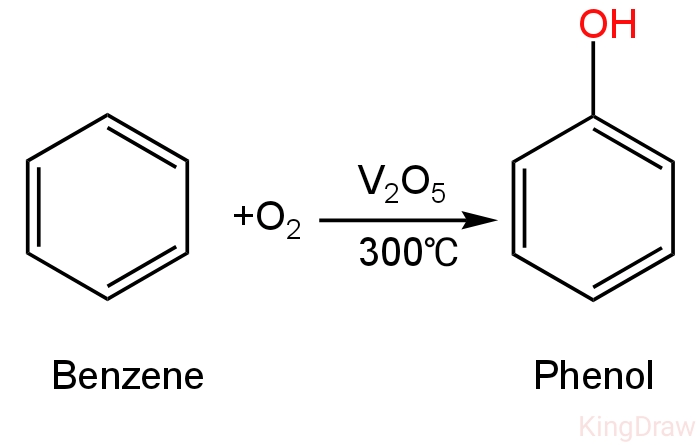
Oxidation of which of the following by air in presence of vanadium pentoxide gives phenol
A. Toluene
B. Benzene
C. Benzaldehyde
D. Phenylacetic acid
Answer
221.1k+ views
Hint: Oxidation of an organic compound is the process of reaction of a compound without oxygen that happens in the presence of an oxidising agent. Phenol is an aromatic organic compound having the molecular formula C6H5OH.
Complete Step by Step Answer:
Phenol has a phenyl group (\[{C_6}{H_5}\]) connected to a hydroxyl group (−OH).
It is mildly acidic and needs cautious handling as it can induce chemical burns.
Oxidation of a compound gives phenol. We have to find out the compound.
A. Toluene
Toluene is a substituted aromatic hydrocarbon.
It has no colour, a water-insoluble liquid with a smell like that of paint thinners.
It is a mono-substituted benzene derivative, having a methyl group (\[C{H_3}\] ) attached to a phenyl group.
Its IUPAC name is methylbenzene.
Oxidation of toluene gives benzoic acid and benzaldehyde in presence of strong oxidising agents like potassium permanganate.
It doesn't give phenol on oxidation with vanadium pentoxide.
So, A is incorrect.
B. Benzene
It is an organic chemical compound having the chemical formula \[{C_6}{H_6}\].
It is composed of six carbon atoms bound in a planar ring with one hydrogen atom connected to each carbon atom.
Benzene on treatment with air in the presence of vanadium pentoxide forms at \[300^\circ C\] temperature and forms phenol.
The reaction happens as follows:

Image: Formation of phenol from benzene.
So, B is correct.
C. Benzaldehyde
Benzaldehyde when exposed to air readily undergoes oxidation by itself to form benzoic acid.
So, C is incorrect.
D. Phenylacetic acid
It is an organic compound comprising a phenyl group and a carboxylic acid group.
It undergoes oxidation to form benzaldehyde.
So, D is incorrect.
Therefore, benzene in reaction with air in presence of vanadium pentoxide forms phenol.
So, option B is correct.
Note: Benzene reacts with air in presence of vanadium pentoxide at \[300^\circ C\] to form phenol. This is known as partial oxidation. But when one molecule of benzene reacts with two molecules of vanadium pentoxide and oxygen at \[500^\circ C\]we get maleic anhydride as the main product.
Complete Step by Step Answer:
Phenol has a phenyl group (\[{C_6}{H_5}\]) connected to a hydroxyl group (−OH).
It is mildly acidic and needs cautious handling as it can induce chemical burns.
Oxidation of a compound gives phenol. We have to find out the compound.
A. Toluene
Toluene is a substituted aromatic hydrocarbon.
It has no colour, a water-insoluble liquid with a smell like that of paint thinners.
It is a mono-substituted benzene derivative, having a methyl group (\[C{H_3}\] ) attached to a phenyl group.
Its IUPAC name is methylbenzene.
Oxidation of toluene gives benzoic acid and benzaldehyde in presence of strong oxidising agents like potassium permanganate.
It doesn't give phenol on oxidation with vanadium pentoxide.
So, A is incorrect.
B. Benzene
It is an organic chemical compound having the chemical formula \[{C_6}{H_6}\].
It is composed of six carbon atoms bound in a planar ring with one hydrogen atom connected to each carbon atom.
Benzene on treatment with air in the presence of vanadium pentoxide forms at \[300^\circ C\] temperature and forms phenol.
The reaction happens as follows:

Image: Formation of phenol from benzene.
So, B is correct.
C. Benzaldehyde
Benzaldehyde when exposed to air readily undergoes oxidation by itself to form benzoic acid.
So, C is incorrect.
D. Phenylacetic acid
It is an organic compound comprising a phenyl group and a carboxylic acid group.
It undergoes oxidation to form benzaldehyde.
So, D is incorrect.
Therefore, benzene in reaction with air in presence of vanadium pentoxide forms phenol.
So, option B is correct.
Note: Benzene reacts with air in presence of vanadium pentoxide at \[300^\circ C\] to form phenol. This is known as partial oxidation. But when one molecule of benzene reacts with two molecules of vanadium pentoxide and oxygen at \[500^\circ C\]we get maleic anhydride as the main product.
Recently Updated Pages
The hybridization and shape of NH2 ion are a sp2 and class 11 chemistry JEE_Main

What is the pH of 001 M solution of HCl a 1 b 10 c class 11 chemistry JEE_Main

Aromatization of nhexane gives A Benzene B Toluene class 11 chemistry JEE_Main

Show how you will synthesise i 1Phenylethanol from class 11 chemistry JEE_Main

The enolic form of acetone contains a 10sigma bonds class 11 chemistry JEE_Main

Which of the following Compounds does not exhibit tautomerism class 11 chemistry JEE_Main

Trending doubts
JEE Main 2026: Application Form Open, Exam Dates, Syllabus, Eligibility & Question Papers

Derivation of Equation of Trajectory Explained for Students

Hybridisation in Chemistry – Concept, Types & Applications

Understanding the Angle of Deviation in a Prism

How to Convert a Galvanometer into an Ammeter or Voltmeter

Degree of Dissociation: Meaning, Formula, Calculation & Uses

Other Pages
NCERT Solutions For Class 11 Chemistry Chapter 7 Redox Reaction

JEE Advanced Marks vs Ranks 2025: Understanding Category-wise Qualifying Marks and Previous Year Cut-offs

Hydrocarbons Class 11 Chemistry Chapter 9 CBSE Notes - 2025-26

Thermodynamics Class 11 Chemistry Chapter 5 CBSE Notes - 2025-26

NCERT Solutions ForClass 11 Chemistry Chapter Chapter 5 Thermodynamics

Equilibrium Class 11 Chemistry Chapter 6 CBSE Notes - 2025-26




